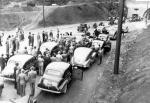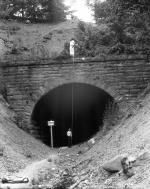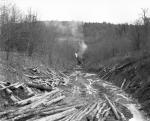![header=[Marker Text] body=[This is one of the original service plazas for the nation's first long-distance superhighway. On October 1, 1940, the Turnpike opened, stretching 160 miles from Irwin to Carlisle. The Turnpike Commission had been created in 1937; construction utilized the old South Pennsylvania Railroad's right-of-way and tunnels. By 1957, the Turnpike spanned 360 miles across the State and extended 110 miles north to Scranton] sign](http://explorepahistory.com/kora/files/1/10/1-A-349-139-ExplorePAHistory-a0l3k5-a_450.gif)
Mouse over for marker text
Name:
Pennsylvania Turnpike [Great Depression]
Region:
Laurel Highlands/Southern Alleghenies
County:
Bedford
Marker Location:
Pennsylvania Turnpike, North and South Midway Service Plazas, just W of
Behind the Marker
When it opened in 1940, the Pennsylvania Turnpike made history as the first limited access superhighway in the nation. Constructed across and through 160 miles of rugged ridges and narrow valleys, the Turnpike was both an engineering marvel and precursor of the national interstate highway system. What is often overlooked, however, is that had New Deal programs not financed the work, the Turnpike would not have been built until many years later, if at all.
The Allegheny Mountains had always presented an imposing barrier to travelers moving east and west across Pennsylvania. Wagon roads, canals, and railroads had, each in turn, connected the two ends of the state. As automobiles and trucks became common modes of transportation, the need arose for a cross-state highway that would allow motorists to cross the state quickly and safely.
U.S. Route 30, the Lincoln Highway, already linked Philadelphia and Pittsburgh, but its antiquated two-lane right-of-way generally followed old wagon roads laid out over a century earlier. As a result, its grades were steep, and its mountainous passes often rendered treacherous by snow, ice, and dense fog. In addition, Route 30 passed through the middle of many towns, where traffic slowed to an agonizing crawl. What was obviously needed, many transportation and state planners believed, was a four-lane, limited access, all-weather highway.
During the 1930s, the proposal for a new cross-state highway emerged within the State Planning Board, an agency that monitored trends in transportation, housing, utilities, and social services, and that also proposed the New Deal work relief projects that created jobs for unemployed Pennsylvanians. Such a highway would be hugely expensive, especially during the Depression years, so the Planning Board proposed to use New Deal funding to build it along a long abandoned and only partially completed right-of-way constructed by railroad magnate William Vanderbilt.
Before work terminated in 1885 on what was later referred to as "Vanderbilt's Folly," 60 percent of the roadbed and 4 ½ miles of tunnels had been completed. It was this right-of-way that fifty years later attracted the attention of those seeking to span the state with a modern highway.
In 1935, the Pennsylvania legislature authorized a feasibility study that estimated construction costs of between $60 million to $70 million. Two years later, Governor George Earle signed a bill authorizing the creation of a Turnpike Commission.
Governor George Earle signed a bill authorizing the creation of a Turnpike Commission.
In the depths of the Great Depression, the Commonwealth had little money to expend on such an ambitious project. Nor did the sale of Turnpike bonds offer a viable financing option, because of the risks involved in a highway project of such an unprecedented scale. As a result, the Turnpike Commission sought financing through federal New Deal programs. Initially, the Commission considered applying to the Works Progress Administration (WPA) for a grant. According to this plan, the state's WPA office would administer the grant and directly employ and supervise the construction workers.
Private contractors quickly objected, arguing that it excluded them from the contracts, and that the WPA's general laborers lacked the skills needed to complete so large and complex a feat of engineering. As an alternative, they proposed that two other New Deal programs, the Reconstruction Finance Corporation (RFC) and the Public Works Administration (PWA), provide the financing.
In response, the Commission and Washington adopted a plan in which the RFC would purchase $40.8 million of the state's Turnpike bonds, and the PWA would provide a grant of $29 million. With financing from New Deal funds, the state contracted private companies to do the work, and agreed to repay the debt with tolls paid by Turnpike motorists.
The PWA grant required that the Turnpike be substantially completed by the end of June, 1940, when the agency was due to be terminated, so there was no time to lose. After groundbreaking for the Turnpike on October 27, 1938, an army of more than 15,000 laborers working for 115 contractors and subcontractors from eighteen states constructed the highway's 160 miles, seven tunnels, and 300 structures.
After the Pennsylvania Turnpike officially opened on October 1, 1940, nearly 27,000 autos crowded the road on its first weekend. The toll of one cent per mile didn't discourage traffic, and neither did the speed limit: initially, the Turnpike had no posted limit.
In its first year, more than two million vehicles used the Pennsylvania Turnpike, which cut travel time in half between Harrisburg and Pittsburgh. One could use the turnpike for a modest fee of $1.50, and then travel at speeds of 80 or 90 miles per hour- it had no posted speed limits - with ease.
During World War II wartime rationing of rubber and gasoline reduced traffic, but the turnpike found a new use transporting military equipment and troops. After the war, pleasure travelers once again flocked to the turnpike, which was soon extended to Valley Forge, then east to New Jersey, and westward to Ohio. The last addition, the Northeast Extension, stretched to Scranton in 1957.
From the standpoint of New Deal programs, the Pennsylvania Turnpike was an overwhelming success on two counts. It provided jobs to thousands of unemployed Pennsylvanians during the Depression. It also provided Pennsylvania the nation's first modern, limited access superhighway, and served as a blueprint for the national interstate highway system begun after President Dwight D. Eisenhower signed into law the Interstate Highway Act of 1956.
To learn more about the construction of the Turnpike's roadbed by the South Pennsylvania Railroad in the 1880s, click here.
here.
The Allegheny Mountains had always presented an imposing barrier to travelers moving east and west across Pennsylvania. Wagon roads, canals, and railroads had, each in turn, connected the two ends of the state. As automobiles and trucks became common modes of transportation, the need arose for a cross-state highway that would allow motorists to cross the state quickly and safely.
U.S. Route 30, the Lincoln Highway, already linked Philadelphia and Pittsburgh, but its antiquated two-lane right-of-way generally followed old wagon roads laid out over a century earlier. As a result, its grades were steep, and its mountainous passes often rendered treacherous by snow, ice, and dense fog. In addition, Route 30 passed through the middle of many towns, where traffic slowed to an agonizing crawl. What was obviously needed, many transportation and state planners believed, was a four-lane, limited access, all-weather highway.
During the 1930s, the proposal for a new cross-state highway emerged within the State Planning Board, an agency that monitored trends in transportation, housing, utilities, and social services, and that also proposed the New Deal work relief projects that created jobs for unemployed Pennsylvanians. Such a highway would be hugely expensive, especially during the Depression years, so the Planning Board proposed to use New Deal funding to build it along a long abandoned and only partially completed right-of-way constructed by railroad magnate William Vanderbilt.
Before work terminated in 1885 on what was later referred to as "Vanderbilt's Folly," 60 percent of the roadbed and 4 ½ miles of tunnels had been completed. It was this right-of-way that fifty years later attracted the attention of those seeking to span the state with a modern highway.
In 1935, the Pennsylvania legislature authorized a feasibility study that estimated construction costs of between $60 million to $70 million. Two years later,
In the depths of the Great Depression, the Commonwealth had little money to expend on such an ambitious project. Nor did the sale of Turnpike bonds offer a viable financing option, because of the risks involved in a highway project of such an unprecedented scale. As a result, the Turnpike Commission sought financing through federal New Deal programs. Initially, the Commission considered applying to the Works Progress Administration (WPA) for a grant. According to this plan, the state's WPA office would administer the grant and directly employ and supervise the construction workers.
Private contractors quickly objected, arguing that it excluded them from the contracts, and that the WPA's general laborers lacked the skills needed to complete so large and complex a feat of engineering. As an alternative, they proposed that two other New Deal programs, the Reconstruction Finance Corporation (RFC) and the Public Works Administration (PWA), provide the financing.
In response, the Commission and Washington adopted a plan in which the RFC would purchase $40.8 million of the state's Turnpike bonds, and the PWA would provide a grant of $29 million. With financing from New Deal funds, the state contracted private companies to do the work, and agreed to repay the debt with tolls paid by Turnpike motorists.
The PWA grant required that the Turnpike be substantially completed by the end of June, 1940, when the agency was due to be terminated, so there was no time to lose. After groundbreaking for the Turnpike on October 27, 1938, an army of more than 15,000 laborers working for 115 contractors and subcontractors from eighteen states constructed the highway's 160 miles, seven tunnels, and 300 structures.
After the Pennsylvania Turnpike officially opened on October 1, 1940, nearly 27,000 autos crowded the road on its first weekend. The toll of one cent per mile didn't discourage traffic, and neither did the speed limit: initially, the Turnpike had no posted limit.
In its first year, more than two million vehicles used the Pennsylvania Turnpike, which cut travel time in half between Harrisburg and Pittsburgh. One could use the turnpike for a modest fee of $1.50, and then travel at speeds of 80 or 90 miles per hour- it had no posted speed limits - with ease.
During World War II wartime rationing of rubber and gasoline reduced traffic, but the turnpike found a new use transporting military equipment and troops. After the war, pleasure travelers once again flocked to the turnpike, which was soon extended to Valley Forge, then east to New Jersey, and westward to Ohio. The last addition, the Northeast Extension, stretched to Scranton in 1957.
From the standpoint of New Deal programs, the Pennsylvania Turnpike was an overwhelming success on two counts. It provided jobs to thousands of unemployed Pennsylvanians during the Depression. It also provided Pennsylvania the nation's first modern, limited access superhighway, and served as a blueprint for the national interstate highway system begun after President Dwight D. Eisenhower signed into law the Interstate Highway Act of 1956.
To learn more about the construction of the Turnpike's roadbed by the South Pennsylvania Railroad in the 1880s, click








